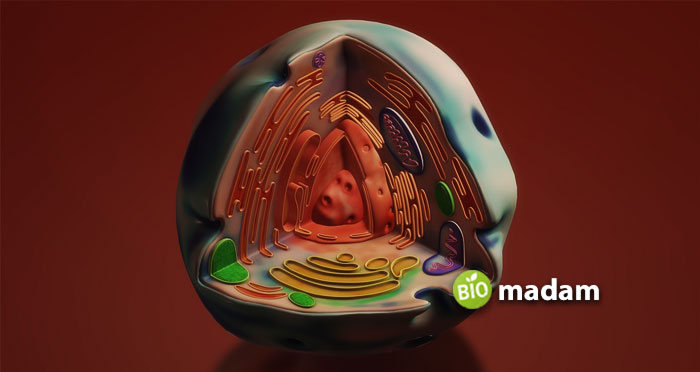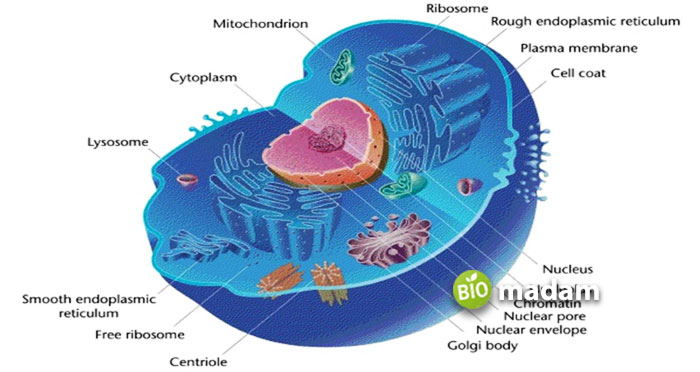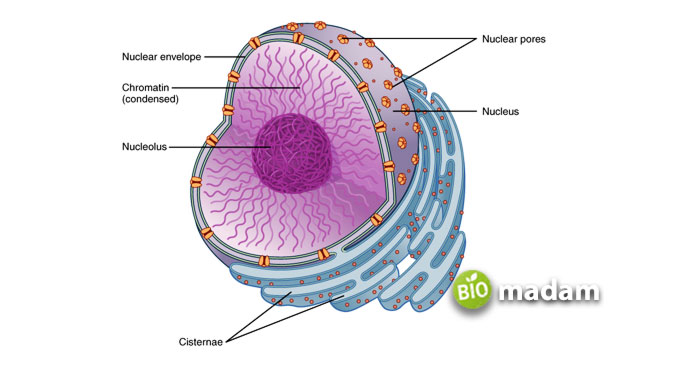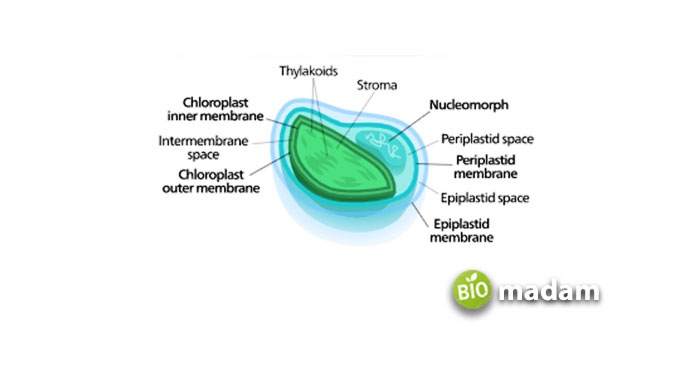Recently updated on August 25th, 2023 at 06:48 am
All living organisms are divided into five kingdoms based on their properties. The two major classifications to which all the five kingdoms belong are; Prokaryotes and Eukaryotes. Prokaryotes have a simple structure and are usually single-celled, while eukaryotes have a complex structure that distinguishes them from prokaryotes. However, some eukaryotes are also unicellular. Let’s talk about eukaryotic organisms in detail.
What are Eukaryotic Cells?
The word Eukaryotic comprises “Eu” and “karyote”, meaning true nucleus. Eukaryotes are given this name as they have a distinct nucleus with a proper membrane. They have more organelles than prokaryotic animals and have an elaborated structure with multiple functions. Most eukaryotes, including humans, animals, fungi, plants, and algae, are multicellular; some eukaryotes are unicellular.

Characteristics of Eukaryotic Cells
The specific structure and functions of eukaryotic cells distinguish them from prokaryotic cells. While there are differences between protists, animal, plant, and fungi eukaryotic cells, they have some common characteristics.
- DNA and chromosomes are the most critical part of a eukaryotic cell.
- All eukaryotic cells have some structures in common like the cell wall, nucleus, mitochondria, endoplasmic reticulum, ribosomes, cytosol or cytoplasm, etc.
- They are significantly bigger than prokaryotic cells.
- All eukaryotic cells are not the same in shape and may vary depending on the cell type.
Types of Eukaryotic Cells
Eukaryotic cells are categorized based on the number of cells they comprise and have two classifications:
- Unicellular eukaryotes
- Multicellular eukaryotes
Unicellular Eukaryotes
They are single-celled eukaryotes with mitochondria, chloroplast, a defined nucleus, and other organelles present in the cell. If you wonder why unicellular eukaryotes are not a part of prokaryotes despite being single-celled, they have properly organized cellular structures compared to prokaryotes. Some examples of unicellular eukaryotes include protozoa, different types of algae, phytoplankton, etc.
Multicellular Eukaryotes
Multicellular eukaryotes are composed of more than one cell, e.g., animals and plants are multicellular eukaryotes having a proper nucleus, mitochondria, and other organelles. The organelles are compartmentalized structures that differentiate eukaryotes from prokaryotes. Multicellular organisms probably have evolved more than once, and the first multicellular organism is believed to be the Prokaryotic Cyanobacteria. Kingdoms that consist of multicellular organisms include plants, animals, and fungi.

Types of Multicellular Eukaryotes
While single-celled eukaryotes are comparatively simple, multicellular eukaryotic cells are classified into four categories depending on their cell differentiation. These include:
Undifferentiated Cells
They are unspecialized cells and go through development through division. Examples include meristematic cells in plants and stem cells in animals.
Differentiated Cells
Unlike undifferentiated cells, differentiated cells have a specialized function and contribute to cell activity. Examples are mesophyll cells in plants.
Dedifferentiated Cells
Dedifferentiated cells are those that become undifferentiated from differentiated ones. The differentiation process is irreversible in animals, yet you may observe dedifferentiation in plant cells. Dedifferentiation allows plant cells to carry out cell division and help in primary and secondary growth, and regeneration.
Redifferentiated Cells
If the reversal process occurs the other way around and dedifferentiated cells become specialized (differentiated) cells again, it is called redifferentiation.
Parts of Eukaryotic Cells
As plants, animals, and fungi all are made of eukaryotic multicellular cells, most organelles in these cells are the same. However, some components in plants and fungi are different from animals. The cell components may be roughly seen under a compound microscope, unlike the electron microscope which shows a detailed view of cell organelles. All structures present in eukaryotic cells are as follows:
Cell Membrane
The cell membrane is the outermost part of the cell that differentiates the inside of the cell from the outside environment. The cell membrane is composed of a lipid bilayer with lipids between an upper and lower layer of proteins. Animal cell membrane, in particular, facilitates material transport in and out of the cell. Similarly, the plant cell membrane functions to signal and maintain the rigidity of a plant cell.
Cell wall
This structure is absent in animals but found in plants and fungi. A cell wall is typically present outside the cell membrane and composed of different components in plants and fungi. The plant cell wall is made of proteins, cellulose, hemicellulose, and pectin. On the other hand, the fungi cell wall has cellulose, mannans, galactans, and calcium carbonate. It saves the cell from injury and gives a defined structure.
Nucleus

The nucleus is the most vital part of the cell and is referred to as the cell’s brain. It has a double membrane and contains all genetic information. A nucleus has 4 parts; nuclear envelope, nucleolus, nucleoplasm, and chromatin (an untangled form of the chromosome). It is the main organelle responsible for reproduction and development.
Mitochondria
Mitochondria are known as the powerhouse of the cell. Like the nucleus, mitochondria also have a double-membrane structure in plant and animal cell. The outer membrane acts as a boundary, while the inner boundary has folds known as cristae. Mitochondria help regulate cell metabolism by providing ATPs. Here’s a fun fact about mitochondria: they have their own DNA, RNA, and other material required to produce proteins.
Endoplasmic Reticulum
The endoplasmic reticulum is a network of tubular structures. It is of two types; smooth endoplasmic reticulum and rough endoplasmic reticulum. Smooth ER is the main site for lipid synthesis, whereas Rough ER has ribosomes involved in protein synthesis.
Ribosomes
Ribosomes are composed of proteins and ribonucleic acids. Ribosomes are involved in the synthesis of polypeptides and proteins. Ribosomes do not have a membrane and act as the central site of protein synthesis in plants and animals. Eukaryotic ribosomes are the 80S with a 60S large subunit and a 40S small subunit.
Golgi Apparatus
The Golgi apparatus is an important location for glycoprotein and glycolipid formation, and is found in both animal and plant cell. It is made of multiple flat disk structures known as cisternae. Golgi plays a major role in packaging material inside the cell and also helps in transporting the proteins.
Lysosomes
Lysosomes are membrane-bounded organelles. These organelles, just like vacuoles and other important structures, are present in animals and plants. Lysosomes play a role in transporting material out of the cell. They are formed in the Golgi apparatus and possess a membrane. They are typically called suicidal bags as they digest, lipids, proteins, carbs, and nucleic acids. Lysosomal enzymes work at optimal pH of less than 7 (acidic pH).
Cytoskeleton
The cytoskeleton is present as a filamentous network in a cell’s cytoplasm. It helps maintain the cell’s shape, facilitates motility, and offers mechanical support.
Plastids

Plastids are specific to plants only and are absent in animal cells. They are double-membrane organelles and play their role in photosynthesis. Plastids contain different pigmented chemicals and perform distinct functions. Plastids are of three types, chloroplasts, chromoplasts, and leucoplasts.
- Chloroplasts contain green pigment and are involved in photosynthesis.
- Chromoplasts have carotene and give yellow, orange, or red color to plants.
- Leucoplasts are colorless and storage sites for carbs, proteins, and saturated/unsaturated fats.
FAQs
Which cell components are present in Prokaryotic and Eukaryotic cells?
While both are different in structure, with prokaryotes not having specialized cell structures like mitochondria, they all have plasma membrane, vacuoles, DNA, cytoplasm, and ribosomes.
Why is the Nucleus Purple?
You might be surprised to know that nucleus is not purple. Instead, it is colorless. When observed under the lab or student microscope, the color of the nucleus comes from the dye used to prepare the slide. The nucleus can be blue or purple, depending on the dye you use.
Do all cells need Mitochondria?
While mitochondria are the powerhouse of the cell, scientists have discovered a unique kind of microorganism that lives without mitochondria.
Do cells never stop Replicating?
Not all cells replicate throughout your lifetime. Cells like nerve cells stop replication when they fully differentiate, while others like skin cells reproduce lifelong.
How many types of Cells are found in the Human Body?
The human body has around 30 trillion cells constituting 200 different cell types exclusive of the bacteria and fungi present in the body.
Conclusion
Eukaryotic cells are present in all organisms having a distinct nucleus. They can range from small algae to large animals, like elephants. Eukaryotic cells are primarily of two types – unicellular eukaryotes and multicellular eukaryotes. Whether it’s a type of unicellular or multicellular cell, they contain double-membrane organelles. Such organisms significantly contribute to making a community, and thus, an ecosystem.

Hello, I would like to introduce myself to you! I am Chelsea Rogers, an experienced blog writer for science articles, holding an MPhil degree. My enthusiasm to grab the best knowledge, let it relate to botany, zoology, or any other science branch. Read my articles & let me wait for your words s in the comment section.

